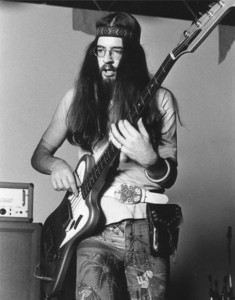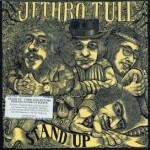Glenn Cornick was, of course, Jethro Tull’s first bassist.
He and Ian did not get along (something that can be said for most of the other 10,000 ex-Tull musicians) so he hit the road after the third album, Benefit.
Nice piece on him, HERE.
I give him some love in the extensive appraisal of Stand Up, below.
Let it suffice to say, his presence on those first three albums is palpable, important and enduring.
The first bit of good news regarding this “collector’s edition” of Stand Up is that you don’t need it. The second bit of good news is that for the most part it already exists, albeit scattered throughout a handful of previously released material. If you already own all of those sets, chances are you are a serious Jethro Tull fan, in which case you’ve probably already acquired this latest installment. To cut through the haze, anyone who has been meaning to pick up this excellent album should know it was remastered earlier this decade (and includes the obligatory bonus tracks), so you can pick that baby up for about a third the cost.
Now to be fair, there is a lot of good “extra” material included in this edition, and only hardcore Tull fans will have all of it in their collections. Various box sets and compilations have featured these BBC sessions as well as the Carnegie Hall concert from 1970. If you already own Stand Up and are interested in hearing some vintage Tull from that era, as well as an extended interview with Ian Anderson, you could do worse. That interview, conducted earlier this year, is the real draw here for fans that already have everything.
All that being said, a question those unfamiliar or unimpressed with Jethro Tull might ask is: what does it matter? It matters because, all other considerations aside (deluxe packaging with original pop-up inside cover, liner notes from Ian Anderson, the first full and unedited version of “With You There To Help Me/By Kind Permission Of” from the Carnegie Hall show (wherein new pianist John Evan does his best Ludwig Van), 5.1 surround sound—but no footage—of the concert), Stand Up is a crucial album in many regards. In addition to serving as the first testament of the band Tull became, and would become, it endures as a meaningful document from what turned out to be a very transitional moment in rock history.So, if this somewhat superfluous new release affords the opportunity for a sustained reappraisal, all the better.
Stand Up may be Jethro Tull’s second album, but it is more like a first than a follow-up, in almost every way. This Was, their proper debut, illustrated the direction which that band might have gone in (keywords: that band). Mick Abrahams, original lead guitarist and co-leader, was no slouch and to his credit knew exactly where he wanted to go. A dedicated acolyte of the blues, Abrahams was all about the old school and dirt-under-the-nails authenticity. His approach is mostly successful on This Was, with songs such as “Move On Alone”, “It’s Breaking Me Up” and the garage rock aggression of “Beggar’s Farm”. On other songs the sound is overly derivative and while never boring, the results are not exactly memorable, unless the design was to sound like third-rate Cream (it was a dubious decision to include “Cat’s Squirrel”, a song featured on Cream’s debut, which suffers by comparison and betrays an opportunism that would have been more honest—and less misguided—if they’d called it “Copycat’s Squirrel”).
In any event, by 1968 that formula (British bands earnestly mimicking American blues legends) was pretty well played out, no matter how convincingly rendered. Even Cream’s debut sounds dated, particularly in comparison with their stunning follow-up Disraeli Gears. In other words, Abrahams had hitched his axe to a locomotive that was going backwards (where he contentedly rode it into semi-obscurity with Bloodwyn Pig), and it is understandable that Ian Anderson envisioned bigger and better—or at least more original—fields for Tull to plow.
Enter Martin Barre, a young but game guitarist whose primary credentials were his lack of experience, which ensured Anderson would never again compete with anyone for control of the band. It is, then, to Anderson’s considerable credit that the resulting album—recorded less than one year later—represents a development that was, and remains, staggering. The dividends Barre delivers are immediate, and well-represented throughout the recording. While one can detect the flute-driven energy of “Beggar’s Farm” in “Back To The Family”, the latter is less a jam and more a proper “song”. Interestingly, both Abrahams and Barre, like every other guitarist in the mid-to-late ‘60s, were listening to a lot of Clapton, and the first two Tull albums are tributes of a sort to the first two Cream albums. To be certain, Barre is less interested in aping Clapton’s riffs and although the blistering outro on “Back To The Family” is a bit of a nod to “God”, it possesses its own unrefined power. While Barre’s playing is not as technically proficient, it’s debatable whether even Clapton can match the emotional heft uncorked on “We Used To Know”, which is cold-finger, raw hangnail material.
There is also ample evidence of the first-rate lyricist Anderson would quickly become. There have not been many 22-year-olds in rock music history who could half-convincingly write songs like “Look Into The Sun”, “We Used To Know” and especially “Reasons For Waiting” (the best song you’ve never heard). These songs are a universe apart from anything on This Was and provide early evidence of the incredibly warm and full sound Anderson gets from his acoustic guitar.
Then there are the familiar songs, some of which continue to get airplay on classic rock radio: “Bouree”, the jazz-rock riff on Bach; “Nothing Is Easy”, the flute-cake manifesto; and the band’s first huge hit, “Living In The Past” (not released on the original album, but included as a bonus track). “A New Day Yesterday” is an ideal opening statement, teasing with nods to the black-and-blues soundscape from ’68, then exploding into Technicolor as Barre’s guitar solo bleeds into Anderson’s frenetic and reverb-laden flute breakdown. Finally, the jocular “Fat Man”, featuring both mandolin and balalaika, a first signal of the folk and eastern influences that would permeate the band’s mature work. There is still a blues sensibility driving most of this material, but Anderson—who clearly had ability and creativity to burn—is already showing signs of developing the multi-faceted approach he would bring to each successive effort.
A few words must be said about Clive Bunker and Glenn Cornick, the drummer and bassist who would not be long for this band (Cornick lasted one more album; Bunker two). While it’s hard to quibble with Bunker’s excellent replacement, Barrie Barlow, Bunker was the perfect drummer for Jethro Tull’s early work. He does restrained as well as explosive, but his accompaniment is always ideal for whatever a particular song calls for. Songs like “Back to the Family” and “For a Thousand Mothers” would be unthinkable without his contributions. Cornick was a top-notch bass player and each new remaster reinforces how busy and brilliant he was in the pocket. He gets room to shine on “Bouree” and “Nothing Is Easy”, but as is often the case with the best bassists, you almost don’t realize he’s there until you stop and consider what a particular song would sound like without him. The charisma and stage antics of Jeffrey Hammond-Hammond became indispensable components of Tull’s charm and overall history, but the loss of Cornick (see: artistic differences, rock music’s version of the pink slip) affected the later music more than Anderson might ever care to admit.
1969 was not merely the conclusion of a decade, it was the end of a succession of eras. These include the British Invasion and the aforementioned blues-by-numbers of those bands (the Beatles, the Rolling Stones, the Animals, Cream, even early Led Zeppelin), psychedelia, art-rock and the eventual, inevitable marriage of precision and pretension that brought us the dreaded “concept album”. By 1970 many of the bands that would become most closely associated with progressive rock (or Prog with a capital P), like King Crimson, Pink Floyd, Genesis, Yes and ELP, were already off the proverbial reservation, crafting side-long suites and noodling away in the manner that captivated listeners and confounded critics.
Stand Up, then, remains rather unique. It is a document created in a rapidly closing artistic window, pre-prog but post-British blues and psychedelic rock. Within two years Jethro Tull would unleash Aqualung and fully, if warily, enter the prog-rock arena (literally and figuratively). Their second album continues to age quite nicely as a hybrid of many sounds, and a reflection of Ian Anderson’s restless vision. Stand Up boasts an ambition and vitality we usually associate with most successful debut albums, but the band is more seasoned and confident, with accordingly impressive results. It still manages to sound unspoiled, an ideal balance of daring and the deliberate.



